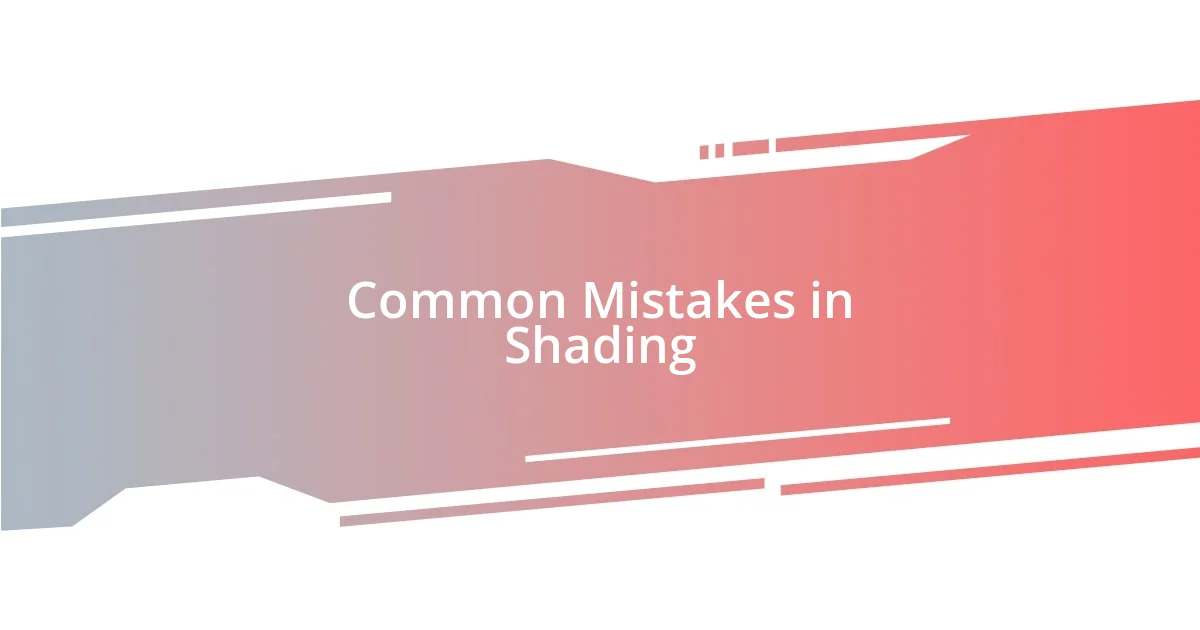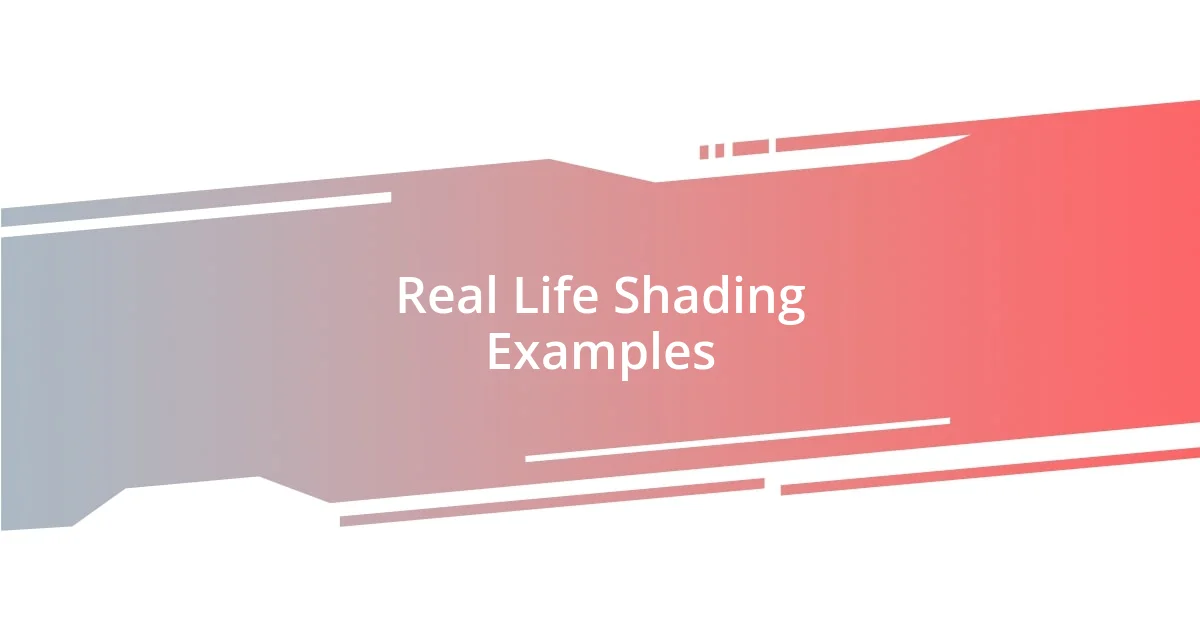Key takeaways:
- Understanding light source direction, surface characteristics, and the surrounding environment is crucial for effective shading.
- Using layering techniques and observing real-life examples enhance depth and texture in artwork.
- Post-project analysis helps identify areas for improvement and examines the emotional impact of shading on the viewer.

Understanding Complex Shading Issues
Complex shading issues can often feel overwhelming, like trying to solve a puzzle without all the pieces. I remember staring at a project, frustrated by the uneven light that seemed to distort everything I created. It made me wonder, why does shading have to be so intricate?
The challenge arises from the interplay of light, form, and context. I’ve learned that understanding the source and direction of light is crucial, but it’s not always intuitive. Have you ever stopped to think about how a simple change in angle can alter the entire mood of a scene?
Every time I tackle a new shading problem, I remind myself that it’s about experimentation. I feel a rush when I finally get it right, but those mistakes along the way have taught me more than any success ever could. Embracing those challenges helps me grow, turning complex shading into an exciting journey rather than a daunting chore.

Identifying Key Elements in Shading
When identifying key elements in shading, I often find it helpful to focus on three main aspects: light source, surface characteristics, and the surrounding environment. Each of these components plays a crucial role in shaping how shadows and highlights interact in my work. For instance, I remember a time when the sunlight streaming through a window created intricate patterns on my subject, revealing textures I hadn’t noticed before. That moment taught me how vital it is to not just observe but to really analyze the light’s impact on the forms around it.
Here’s a quick breakdown of what to consider:
- Light Source: What direction is it coming from, and how intense is it?
- Surface Characteristics: Is the surface smooth, rough, or reflective?
- Surrounding Environment: What are the colors and materials nearby that might affect the overall shading?
By honing in on these elements, I’ve learned to create depth in my art, transforming simple images into compelling visual stories.

Techniques for Effective Shading
When it comes to effective shading techniques, I’ve found that a structured approach works wonders. One method I rely on is layering. When I was learning to paint, I’d often start with a base layer and gradually build up darker shades. This gradual process revealed nuances in texture that simply weren’t possible with a single stroke. It’s fascinating how depth unfolds with each added layer, creating a vibrant, dynamic image.
Utilizing a variety of brushes or tools can significantly enhance shading, too. I once experimented with a sponge for certain textures and was pleasantly surprised by the soft gradients it created. This taught me the value of being versatile with my tools, which opened my eyes to new possibilities in shading that I hadn’t considered before.
Finally, observing from life impacts my shading technique immensely. I remember sitting in a café, mesmerized by how light played off the surfaces around me. By skimming my gaze across different objects, I realized that the richer the observation, the more life I could capture in my artwork. This practice reminds me that the world is a constant source of inspiration if I take the time to really look.
| Technique | Description |
|---|---|
| Layering | Building up shades gradually for depth |
| Tool Variety | Using different brushes and sponges for texture |
| Life Observation | Studying light in real-life settings |

Step by Step Shading Solutions
Shading can be incredibly nuanced, and I’ve developed a step-by-step approach that has simplified the process for me. For instance, I often start by sketching out the basic forms of the object I’m shading. This initial step is crucial because it allows me to visualize where the light hits and where shadows need to fall. I remember a moment when I was working on a portrait; once I outlined the face, I could see the shadows under the chin and cheekbones emerge, making the image feel three-dimensional and alive.
Next, I lay down a midtone as a foundation. This is where I like to keep it light and playful. Imagine blending a soft gray across a surface; it delights me to see how it invites darker shades to rest atop it later, creating a beautiful contrast. Just recently, I worked with pastel colors, layering a soft pink before adding deeper hues. That experience reminded me of how important the midtone is—it sets the stage for everything that follows.
Lastly, I focus on the finishing touches, which can truly elevate the artwork. I often ask myself, “What details will bring this piece to life?” A small highlight can drastically change the outcome, so I pick up my finest brush and delicately apply lighter shades where light reflects. I once spent hours perfecting the glimmer of light in a glass vase, feeling an overwhelming sense of satisfaction as it transformed from flat to strikingly real. It’s in these moments that I find the true joy of shading—it’s all about the subtlety and the stories each shadow tells.

Common Mistakes in Shading
So, one common mistake I see often in shading is not understanding the importance of light source direction. I remember my early days when I’d shade without really considering where the light was coming from. The result? Flat, lifeless sketches that didn’t convey depth. When I finally took the time to observe how shadows behave based on light, it was like flipping a switch. Suddenly, my work had dimension and sparkle, making it feel dynamic and vivid.
Another issue I’ve noticed is overdoing the darkness. There was a time when I believed that the deeper the shade, the more impressive it looked. However, I learned through trial and error that too much darkness can overwhelm the finer details and create a muddy appearance. I recall an art piece where I was so eager to highlight contrast that I buried the delicate textures with heavy-handed shading. Now, I aim for balance, allowing lighter shades to intersperse with darker ones, which adds richness without drowning the piece in darkness.
Lastly, many aspiring artists overlook blending techniques. I once rushed through blending, thinking I could fix it in the end. What I found is that poor blending can create harsh lines that distract from the overall harmony of a piece. In my experience, taking the time to gently smooth out transitions makes all the difference. I often ask myself, “How can I make this flow together seamlessly?” That commitment to blending has truly transformed my shading, lending a softness that invites the viewer in.

Real Life Shading Examples
Exploring real-life shading examples truly brings the concepts to life. For instance, I remember working on a landscape painting where the sun was setting behind the mountains. The colors involved were vibrant oranges and deep purples, creating a complex interplay of light and shadow. As I layered the shadows on the slopes, I felt the depth really take shape, transforming the scene into a moment frozen in time.
On another occasion, I was tasked with shading a simple still life that included a bowl of fruit. It seemed straightforward at first, but when I focused on the subtle differences in shading on each piece of fruit, I was amazed at how they could appear almost lifelike. The way light danced off the glossy apple compared to the soft matte surface of the pear highlighted the importance of understanding texture in shading. It reminded me that every object has its unique character and story to tell through shading.
I often ask myself how different light sources can completely alter the mood of a piece. During a late-night sketching session, I used a single lamp as my light source, which cast dramatic shadows across my sketchbook. The elongated shapes and stark contrasts reminded me of classic chiaroscuro techniques, making my pencil feel more like a magic wand. Engaging with this technique truly opened my eyes to the emotional power of shadows, showing that even a simple object can evoke a sense of drama when shaded thoughtfully.

Post Shading Problem Analysis
After completing a shading project, I always take a moment to reflect on what went well and what didn’t. Recently, while working on a portrait, I found that some areas needed more subtlety than I initially provided. I asked myself, “Why does this skin tone look flat?” That self-questioning opened my eyes to the importance of layering different shades, which added warmth and personality that I had overlooked.
In addition to assessing my technique, I also consider how the overall mood of the piece came across to the viewer. During a study of textures on a fabric draped over a chair, I realized the shadows weren’t just shadows but conduits of emotion, creating a specific atmosphere in the artwork. I reflected on how the shadows could either evoke calmness or tension, depending on how I positioned them. This experience taught me that post shading analysis isn’t merely a technical evaluation; it’s a journey into understanding the emotional impact of my artistic choices.
Finally, sharing my work with peers has become an invaluable part of my post-shading analysis. After exhibiting a recent piece, I received feedback that highlighted areas where my shading evoked different interpretations than I intended. Each critique felt like a conversation with fellow artists, helping me recognize the depth of interpretation in shading and encouraging me to evolve my technique. I now approach my shading with the mindset that it’s not just about what I see, but how others perceive it.















